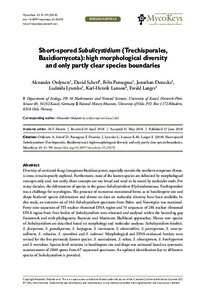Datum
2018-06-27Autor
Ordynets, AlexanderScherf, DavidPansegrau, FelixDenecke, JonathanLysenko, LudmilaLarsson, Karl-HenrikLanger, EwaldSchlagwort
570 Biowissenschaften, BiologieMetadata
Zur Langanzeige
Aufsatz
Artikel (Publikationen im Open Access gefördert durch die UB)

Short-spored Subulicystidium (Trechisporales, Basidiomycota): high morphological diversity and only partly clear species boundaries
Zusammenfassung
Diversity of corticioid fungi (resupinate Basidiomycota), especially outside the northern temperate climatic zone, remains poorly explored. Furthermore, most of the known species are delimited by morphological concepts only and, not rarely, these concepts are too broad and need to be tested by molecular tools. For many decades, the delimitation of species in the genus Subulicystidium (Hydnodontaceae, Trechisporales) was a challenge for mycologists. The presence of numerous transitional forms as to basidiospore size and shape hindered species delimitation and almost no data on molecular diversity have been available. In this study, an extensive set of 144 Subulicystidium specimens from Paleo- and Neotropics was examined. Forty-nine sequences of ITS nuclear ribosomal DNA region and 51 sequences of 28S nuclear ribosomal DNA region from fruit bodies of Subulicystidium were obtained and analysed within the barcoding gap framework and with phylogenetic Bayesian and Maximum likelihood approaches. Eleven new species of Subulicystidium are described based on morphology and molecular analyses: Subulicystidium boidinii, S. fusisporum, S. grandisporum, S. harpagum, S. inornatum, S. oberwinkleri, S. parvisporum, S. rarocrystallinum, S. robustius, S. ryvardenii and S. tedersooi. Morphological and DNA-evidenced borders were revised for the five previously known species: S. naviculatum, S. nikau, S. obtusisporum, S. brachysporum and S. meridense. Species-level variation in basidiospore size and shape was estimated based on systematic measurements of 2840 spores from 67 sequenced specimens. An updated identification key to all known species of Subulicystidium is provided.
Zitierform
In: MycoKeys. - Washington, DC [u.a.] : Pensoft Publishers. - 35:41-99(2018)Förderhinweis
Gefördert durch den Publikationsfonds der Universität KasselSammlung(en)
Publikationen (Fachgebiet Ökologie)Artikel (Publikationen im Open Access gefördert durch die UB)
Zitieren
@article{urn:nbn:de:hebis:34-2018082156266,
author={Ordynets, Alexander and Scherf, David and Pansegrau, Felix and Denecke, Jonathan and Lysenko, Ludmila and Larsson, Karl-Henrik and Langer, Ewald},
title={Short-spored Subulicystidium (Trechisporales, Basidiomycota): high morphological diversity and only partly clear species boundaries},
year={2018}
}
0500 Oax 0501 Text $btxt$2rdacontent 0502 Computermedien $bc$2rdacarrier 1100 2018$n2018 1500 1/eng 2050 ##0##urn:nbn:de:hebis:34-2018082156266 3000 Ordynets, Alexander 3010 Scherf, David 3010 Pansegrau, Felix 3010 Denecke, Jonathan 3010 Lysenko, Ludmila 3010 Larsson, Karl-Henrik 3010 Langer, Ewald 4000 Short-spored Subulicystidium (Trechisporales, Basidiomycota): high morphological diversity and only partly clear species boundaries / Ordynets, Alexander 4030 4060 Online-Ressource 4085 ##0##=u http://nbn-resolving.de/urn:nbn:de:hebis:34-2018082156266=x R 4204 \$dAufsatz 4170 7136 ##0##urn:nbn:de:hebis:34-2018082156266
<resource xsi:schemaLocation="http://datacite.org/schema/kernel-2.2 http://schema.datacite.org/meta/kernel-2.2/metadata.xsd"> 2018-08-21T13:08:54Z 2018-08-21T13:08:54Z 2018-06-27 1314-4049 urn:nbn:de:hebis:34-2018082156266 http://hdl.handle.net/123456789/2018082156266 Gefördert durch den Publikationsfonds der Universität Kassel eng Urheberrechtlich geschützt https://rightsstatements.org/page/InC/1.0/ basidiospores biodiversity biometry crystals cystidia DNA barcode encrustation genetic distance internal transcribed spacer large subunit species delimitation taxonomy 570 Short-spored Subulicystidium (Trechisporales, Basidiomycota): high morphological diversity and only partly clear species boundaries Aufsatz Diversity of corticioid fungi (resupinate Basidiomycota), especially outside the northern temperate climatic zone, remains poorly explored. Furthermore, most of the known species are delimited by morphological concepts only and, not rarely, these concepts are too broad and need to be tested by molecular tools. For many decades, the delimitation of species in the genus Subulicystidium (Hydnodontaceae, Trechisporales) was a challenge for mycologists. The presence of numerous transitional forms as to basidiospore size and shape hindered species delimitation and almost no data on molecular diversity have been available. In this study, an extensive set of 144 Subulicystidium specimens from Paleo- and Neotropics was examined. Forty-nine sequences of ITS nuclear ribosomal DNA region and 51 sequences of 28S nuclear ribosomal DNA region from fruit bodies of Subulicystidium were obtained and analysed within the barcoding gap framework and with phylogenetic Bayesian and Maximum likelihood approaches. Eleven new species of Subulicystidium are described based on morphology and molecular analyses: Subulicystidium boidinii, S. fusisporum, S. grandisporum, S. harpagum, S. inornatum, S. oberwinkleri, S. parvisporum, S. rarocrystallinum, S. robustius, S. ryvardenii and S. tedersooi. Morphological and DNA-evidenced borders were revised for the five previously known species: S. naviculatum, S. nikau, S. obtusisporum, S. brachysporum and S. meridense. Species-level variation in basidiospore size and shape was estimated based on systematic measurements of 2840 spores from 67 sequenced specimens. An updated identification key to all known species of Subulicystidium is provided. open access In: MycoKeys. - Washington, DC [u.a.] : Pensoft Publishers. - 35:41-99(2018) Ordynets, Alexander Scherf, David Pansegrau, Felix Denecke, Jonathan Lysenko, Ludmila Larsson, Karl-Henrik Langer, Ewald doi:10.3897/mycokeys.35.25678 </resource>
Die folgenden Lizenzbestimmungen sind mit dieser Ressource verbunden:
Urheberrechtlich geschützt

